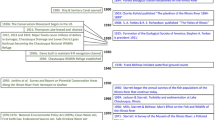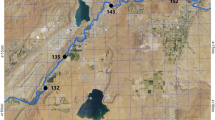Abstract
Disturbance in a river-floodplain system is defined as an unpredictable event that disrupts structure or function at the ecosystem, community, or population level. Disturbance can result in species replacements or losses, or shifts of ecosystems from one persistent condition to another. A disturbance can be a discrete event or a graded change in a controlling factor that eventually exceeds a critical threshold.
The annual flood is the major driving variable that facilitates lateral exchanges of nutrients, organic matter, and organisms. The annual flood is not normally considered a disturbance unless its timing or magnitude is “atypical.” The record flood of 1973 had little effect on the biota at a long-term study site on the Mississippi River, but the absence of a flood during the 1976–1977 Midwestern drought caused short- and long-term changes. Body burdens of contaminants increased temporarily in key species, because of increased concentration resulting from reduced dilution. Reduced runoff and sediment input improved light penetration and increased the depth at which aquatic macrophytes could grow. Developing plant beds exerted a high degree of biotic control and were able to persist, despite the resumption of normal floods and turbidity in subsequent years.
In contrast to the discrete event that disturbed the Mississippi River, a major confluent, the Illinois River, has been degraded by a gradual increase in sediment input and sediment resuspension. From 1958 to 1961 formerly productive backwaters and lakes along a 320-km reach of the Illinois River changed from clear, vegetated areas to turbid, barren basins. The change to a system largely controlled by abiotic factors was rapid and the degraded condition persists.
Traditional approaches to experimental design are poorly suited for detecting control mechanisms and for determining the critical thresholds in large river-floodplains. Large river-floodplain systems cannot be manipulated or sampled as easily as small streams, and greater use should be made of man-made or natural disturbances and environmental restoration as opportunistic experiments to measure thresholds and monitor the recovery process.
Similar content being viewed by others
Literature Cited
Anderson, R. V., and D. M. Day. 1986. Predictive quality of macroinvertebrate-habitat associations in lower navigation pools of the Mississippi River.Hydrobiologia 136:101–112.
Bellrose, F. C., F. L. Paveglio, Jr., and D. Steffeck. 1979. Waterfowl populations and the changing environment of the Illinois River valley.Illinois Natural History Survey Bulletin 32(1):1–54.
Belt, C. B., Jr. 1975. The 1973 flood and man's constriction of the Mississippi River.Science 189:681–684.
Bhowmik, N. G., J. R. Adams and R. E. Sparks. 1986. Fate of a navigation pool on the Mississippi River.Journal of Hydraulic Engineering 112(10):967–970.
Cairns, J. C., Jr. 1987. Disturbed ecosystems as opportunities for research in restoration ecology. Pages 307–320in W. R. Jorden III, M. E. Gilpin, and J. D. Aber (eds.), Restoration ecology: a synthetic approach to ecological research. Cambridge University Press, New York.
Cummins, K. W. 1977. From headwater streams to rivers.American Biology Teacher 39:305–312.
Fisher, S. G. 1983. Succession in streams. Pages 7–27in J. R. Barnes and G. W. Minshall (eds.), Stream ecology: application and testing of general ecological theory. Plenum Press, New York.
Galtsoff, P. 1923. Limnological observations in the upper Mississippi, 1921.Bulletin of the Bureau of Fisheries 34:347–438.
Grubaugh, J. W., and R. V. Anderson. 1988. Spatial and temporal availability of floodplain habitat: long-term changes at Pool 19, Mississippi River.American Midland Naturalist 119:402–411.
Grubaugh, J. W., and R. V. Anderson. 1989. Upper Mississippi River: seasonal and floodplain forest influences on organic matter transport.Hydrobiologia 174:235–244.
Hagen, R., L. Werth, and M. Meyer. 1977. Upper Mississippi River habitat inventory. Research Report 77-5, Remote Sensing Laboratory, University of Minnesota, St. Paul, Minnesota. 44 pp.
Herricks, E. E., and L. L. Osborne. 1985. Water quality protection and restoration in streams and rivers. Pages 1–20in J. Gore (ed.), Restoration of rivers and streams. Ann Arbor Press, Ann Arbor, Michigan.
Hey, D. L., J. M. Stockdale, D. Kropp, and G. Wilhelm. 1982. Creation of wetland habitats in northeastern Illinois. Illinois Department of Energy and Natural Resources Document No. 82/09, Springfield. 117 pp.
Illinois Department of Conservation. 1988. Banner Marsh state fish and wildlife area, Rice Lake state fish and wildlife area, natural resource management plan. Illinois Department of Conservation, 520 South Second St., Springfield, Illinois 62706. 97 pp.
Jackson, H. O., and W. C. Starrett. 1959. Turbidity and sedimentation at Lake Chautauqua, Illinois.Journal of Wildlife Management 23(2):157–168.
Jahn, L. A., and R. V. Anderson. 1986. The ecology of pools 19 and 20, Upper Mississippi River: a community profile.US Fish and Wildlife Service Publication, Biological Reports 85(7.6):1–142.
Junk, W. J., P. B. Bayley, and R. E. Sparks. 1989. The flood pulse concept in river-floodplain systems. Pages 110–127in D. P. Dodge (ed.), Proceedings of the International Large River Symposium.Canadian Special Publication of Fisheries and Aquatic Sciences 106.
Moll, D. 1977. Ecological investigations of turtles in a polluted ecosystem: the central Illinois River and adjacent floodplain lakes. PhD dissertation. Illinois State University, Normal, Illinois. 194 pp.
Pickett, S. T. A., and P. S. White (eds.), 1985. The ecology of natural disturbance and patch dynamics. Academic Press, Orlando, Florida.
Rasmussen, J. L., and J. H. Wlosinski. 1988. Operating plan of the long-term resource monitoring program for the Upper Mississippi River System. US Fish and Wildlife Service, Environmental Management Technical Center, 575 Western Drive, Onalaska, Wisconsin 54650. 51 pp.
Resh, V. H., A. V. Brown, A. P. Covich, M. E. Gurtz, H. W. Li, G. W. Minshall, S. R. Reice, A. R. Sheldon, J. B. Wallace, and R. C. Wissmar. 1988. The role of disturbance in stream ecology.Journal of the North American Benthological Society 7:433–455.
Roelle, J. E., D. B. Hamilton, and R. L. Johnson. 1989. Refuge management analyses: restoration of Thompson Lake as an alternative for Chautauqua National Wildlife Refuge. US Fish and Wildlife Service, National Ecology Research Center, Creekside 1 Building, 2627 Redwing Road, Fort Collins, Colorado 80526. 200 pp.
Schnick, R. A., J. M. Morton, C. Mochalski, and J. T. Bell. 1982. Mitigation and enhancement techniques for the upper Mississippi River system and other large river systems. US Fish and Wildlife Service Editorial Office, Aylesworth Hall, Colorado State University, Fort Collins, Colorado 80523.
Serie, J. R., D. L. Trauger, and D. E. Sharp. 1983. Migration and winter distributions of canvasbacks staging on the upper Mississippi River.Journal of Wildlife Management 47:741–753.
Sparks, R. E. 1980. Response of the fingernail clam populations in the Keokuk Pool (Pool 19) to the 1976–1977 drought. Pages 43–71in J. L. Rasmussen (ed.), Proceedings of the UMRCC symposium on Upper Mississippi River bivalve mollusks; 3–4 May 1979, Sheraton Rock Island Motor Inn, Rock Island, Illinois. Upper Mississippi River Conservation Committee, Rock Island.
Sparks, R. E. 1984. The role of contaminants in the decline of the Illinois River: implications for the upper Mississippi. Pages 25–66in J. G. Weiner, R. V. Anderson, and D. R. McConville (eds.), Contaminants in the upper Mississippi River. Butterworth Publishers, Stoneham, Massachusetts.
Steffeck, D. W., F. L. Paveglio, and C. E. Korschgen. 1985. Distribution of aquatic plants in Keokuk Pool (Navigation Pool 19) of the Upper Mississippi River.Proceedings of the Iowa Academy of Science 92(3):111–114.
Twait, R., D. Roseboom, and T. Hill. 1989. Restoration of a backwater lake habitat using a tire reef and vegetation in Peoria Lake, Illinois River. Pages 5–16in Proceedings of the 44th Annual Meeting of the Upper Mississippi River Committee, Rock Island, Illinois. 177 pp.
US Army Corps of Engineers. 1985. Upper Mississippi River system environmental management plan. General Plan. US Army Corps of Engineers, North Central Division, Chicago, Illinois 60605. 31 pp.
Vannote, R. L., G. W. Minshall, K. W. Cummins, J. R. Sedell, and C. E. Cushing. 1980. The river continuum concept.Canadian Journal of Fisheries and Aquatic Sciences 37:130–137.
Author information
Authors and Affiliations
Additional information
Coauthors are listed in alphabetical order.
Rights and permissions
About this article
Cite this article
Sparks, R.E., Bayley, P.B., Kohler, S.L. et al. Disturbance and recovery of large floodplain rivers. Environmental Management 14, 699–709 (1990). https://doi.org/10.1007/BF02394719
Issue Date:
DOI: https://doi.org/10.1007/BF02394719




